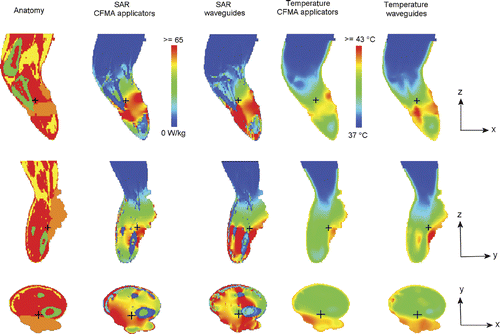Comparison of two different 70 MHz applicators for large extremity lesions: simulation and application
Unfortunately an error occurred in the simulations performed in the preparation of the paper. This error was discovered following online publication but prior to the print edition.
The source description of the second CFMA led to an unintended phase shift, resulting in suboptimal heating of the leg. This means that the differences in dose distribution are far less significant than the numbers and figures suggest. The difference in absorption in fat for CFMAs still holds but has little consequences for this patient who has very little fat in the first place. The main effective difference remaining between the CFMA and the waveguide is the limitation in output power of the CFMA antenna, the conclusion that the waveguide is preferred still holds and may be stronger for treatment sites with more normal amounts of fat.
This has the following consequences for the text:
In the results section of the abstract the sentence “Simulations results…. twice as high with CFMAs.” should be replaced by “Simulation results confirmed the better performance of the waveguides. For normal amounts of fat tissue, approximately twice as much power is absorbed in fat with CFMAs compared to waveguides”.
In the “Results”, section “patient simulations”, subsection “treatment simulations” the third sentence “For example, the difference in T90 was 0.8°C and for T50 a difference of 2.7°C was found in favour of the waveguides” should be replaced by “For example, the values for T90 were comparable, but for T50 a difference of 1.9°C was found in favour of the waveguides”. The statements on the impact of the water temperature remain valid.
In the section “patient simulations”, subsection “theoretical comparison of the two applicator types” many of the results for the CFMA are different and considerably closer to the waveguide results:
The 94 W absorbed power in the leg for the CFMA becomes 101W, which still implies ∼20% more absorbed power in the leg with waveguides (122W; second paragraph).
The absorption in the tumour tissue is now 16% higher for waveguides compared to CFMA, instead of 75%. The difference in absorption in fat tissue is not pronounced, which can be explained by the low amount of fatty tissue in the lower leg (third paragraph).
The difference in T50 is no longer 1°C in favour of the waveguides for a water bath temperature of 38°C, but close to 0°C (fourth paragraph).
When the water bath temperature was increased from 38°C to 42°C the value of T90 increased approximately 2°C for both CFMA applicators and waveguides. The temperature rise and homogeneity is no longer significantly different for CFMAs and waveguides (fourth paragraph).
The remarks on the CFMAs in the fifth paragraph “with CFMAs …. 42–44°C” are no longer valid, results are similar to the waveguide results.
In the “Discussion”, section the claim of a more favourable power absorption for waveguides compared to CFMAs mentioned in the last sentence of the first paragraph is still valid, but the difference is less significant than initially claimed in the paper. As mentioned in the fifth paragraph, the difference in fat absorption will generally result in more difficulties than encountered in the specific application presented in this paper.
The sixth paragraph is still correct in pointing out the practical power limitation of 120W per channel for the CFMAs, but incorrect in assuming normal tissue limitations when higher powers would have been possible.
In the “Conclusion”, “Simulations showed a higher power absorption in tumour tissue (∼75%) for waveguides.” Should be replaced by “Simulations showed a slightly higher power absorption in tumour tissue (∼16%) for waveguides.”
The last sentence on higher fat absorption duplicates part of the first sentence and can be removed.
should be replaced by:
Table IV. Simulated steady state tumour temperatures for treatment 3 and 4, determined over the complete tumour volume. A constant power and water bath temperature was assumed.
should be replaced by:
Table V. Average simulated SAR values (W/kg) in tumour, muscle and fat tissue, using CFMA applicators or waveguides.
should be replaced by:
Table VI. Simulated steady state temperatures, determined over the complete tumour volume, heterogeneity coefficients and maximum temperatures achieved in tumour, muscle and fat tissue with CFMA applicators and waveguides.
NB for all Tables, waveguide results were unchanged.
The graphs for CFMAs are closer to the graphs for waveguides than the original figure suggests.
Figure 10. Cross sections of the simulated SAR and temperature distributions with CFMA and waveguide applicators. In both cases, the water bath temperature was 42 °C and the absorbed power 200W in tissue and water bath. The colours red, yellow and green in the anatomy represent muscle, fat and bony tissue, respectively and tumour tissue is orange. The small black cross hair indicates the location of the cross sections.

